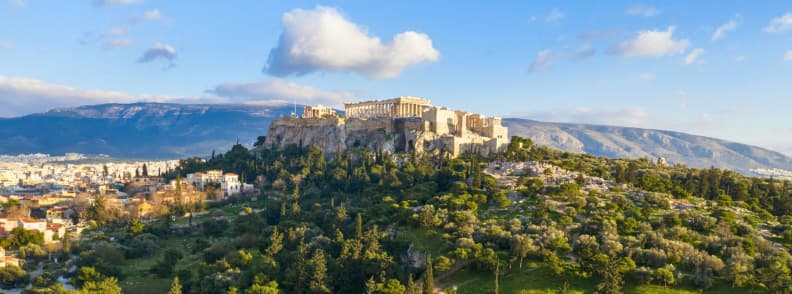Planning a trip to Athens and wondering which archaeological sites are worth visiting? Or maybe you live here and want to dive deeper into the rich history of ancient Athens? Either way, this guide has you covered.
From the towering columns of the Acropolis to the hidden gems of Kerameikos, I’ll take you through the most fascinating ancient sites in Athens, sharing first-hand insights, essential tips, and local secrets to help you make the most of your visit.
Athens Archaeological Sites Guide
The city of Athens is a living museum. Every step you take is layered with thousands of years of history, from the birthplace of democracy in the Ancient Agora to the grandeur of the Temple of Olympian Zeus. But with so much to see, where do you even start? That’s exactly why I’ve put together this practical, experience-based guide to help you navigate Athens’ archaeological sites efficiently.
From this Athens travel guide, you get a detailed look at the top archaeological sites in Athens, including must-see landmarks, hidden corners, and historical context, together with insider tips on the best times to visit, how to beat the crowds, and where to find the best photo spots. Last but not least, I’ll give you a breakdown of the Athens Archaeological Sites Pass. Is it worth it, and how can it save you money? Learn everything from a real traveler’s perspective, with firsthand experiences and recommendations to make your visit smoother, whether you’re a history buff, a casual explorer, or a local rediscovering the city.
Athens’ ancient sites are more than just ruins; they’re windows into the past, telling stories of philosophers, warriors, emperors, and everyday Athenians who walked these streets long before us. Whether you’re here for a short city break or planning an in-depth historical tour, this guide will help you explore the best archaeological sites in Athens like a pro.
Let’s step back in time and uncover the best of Athens’ ancient sites, starting with the legendary Acropolis.
Disclosure: Some of the links below are affiliate links. This means that at no extra cost to you, The Travel Bunny will earn a small commission if you click through and make a purchase.
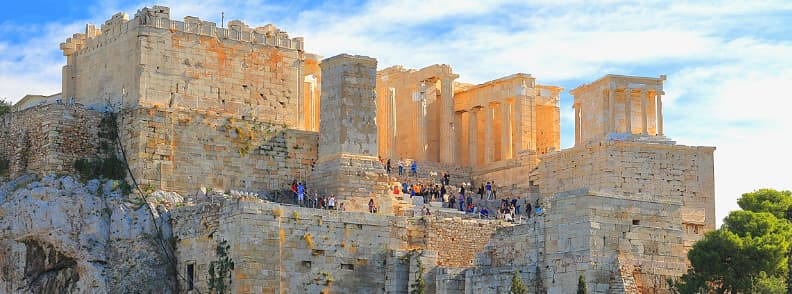
1. The Acropolis, Athens’ Crown Jewel
No visit to Athens’ archaeological sites is complete without stepping onto the Acropolis, the city’s most famous landmark and an enduring symbol of Greek civilization. Sitting high above Athens, this UNESCO World Heritage Site is a time capsule of ancient glory, home to some of the most iconic ancient sites in Athens.
Built in the 5th century BC, the Acropolis Athens was designed to showcase the power and culture of classical Athens. Today, it still dominates the skyline, offering breathtaking views over the city and a chance to walk in the footsteps of philosophers, kings, and warriors. Whether you’re a history buff, a first-time visitor, or a local rediscovering your city, exploring the Acropolis of Athens is an unforgettable experience.
What to visit on the Acropolis of Athens
1. The Parthenon, the Icon of Ancient Greece
The Parthenon is the star attraction of the Acropolis Athens and one of the most recognized Greek archaeological sites worldwide. This all-marble temple, dedicated to Athena Parthenos, was built to celebrate Athens’ victory over the Persians. Its perfect symmetry and Doric columns have influenced architecture across the world.
Pro Athens Travel Tip: Visit in the late afternoon for the best golden-hour lighting. The sunset views from the Acropolis are magical and perfect for photography.
2. The Erechtheion, the Home of the Caryatids
Unlike the Parthenon Athens, which embodies power, the Erechtheion is known for its graceful elegance. This asymmetrical temple was dedicated to both Athena and Poseidon, making it one of the most sacred sites in ancient Athens. Its most famous feature? The Caryatid Porch, where six female statues (Caryatids) serve as columns.
Local Tip: The Caryatids on-site are replicas. The originals are preserved in the Acropolis Museum (except for one, which is controversially in the British Museum).
3. The Theater of Dionysus Eleuthereus, the Birthplace of Drama
On the southern slope of the Acropolis area, the Theater of Dionysus Eleuthereus is one of the oldest theaters in the world. This was where Sophocles, Euripides, and Aristophanes staged their legendary plays, bringing tragedy and comedy to life. The theater could once hold 17,000 spectators, making it a central hub of Athenian culture.
Fun Fact: This is where Greek drama was born. The same plays you studied in school were likely performed here first!
4. The Temple of Athena Nike, Guardian of Victory
Perched on the southwestern edge of the Acropolis, the Temple of Athena Nike was dedicated to Athena the Victorious. Unlike other grand temples, this one is small yet elegant, symbolizing the city’s desire to remain unconquered.
Insider Tip: This strategic location was meant to protect the Acropolis’ most vulnerable side from enemy attacks.
5. The Panathenaic Way, a Road of Rituals
The Panathenaic Way was the main route leading through ancient Athens to the Acropolis. It played a key role in the Panathenaic Festival, a grand procession honoring Athena, where Athenians would offer a new robe (peplos) to the goddess along with sacrifices.
Hidden Detail: While walking up, imagine the elaborate processions of ancient Athens, with priests, musicians, and sacrificial animals making their way toward the Parthenon.
6. The Odeon of Herodes Atticus, Where Ancient Music Lives On
Unlike other ruins, the Odeon of Herodes Atticus is still in use today! Built in 161 AD, this grand Roman amphitheater was constructed by Herodes Atticus in memory of his wife. It originally had a wooden roof, making it unique among ancient theaters.
Experience Today: During summer, the Athens & Epidaurus Festival brings the Odeon back to life with concerts and theatrical performances under the stars.
7. Beulé Gate & Propylaea, the Grand Entrance
Most visitors rush past the Beulé Gate, but it’s an interesting Roman-era addition that serves as an extra layer of defense. Beyond it lies the Propylaea, the monumental 5th-century BC entranceway, which was meant to awe visitors even before they stepped inside the Acropolis.
Hidden Detail: Look for the holes in the marble. They used to hold bronze anchors to secure statues and decorations.
Plan Your Visit to the Acropolis of Athens
The Acropolis of Athens is located on Dionysiou Areopagitou Street, Athens 10558, easily accessible from the city center. It is one of the most visited archaeological sites in Athens, drawing millions of travelers every year. The best entrance to the Acropolis is through the South Slope, as it is less crowded than the main entrance.
The opening hours vary by season. From April to October, the site is open daily from 8 AM to 8 PM, allowing visitors to explore under the warm Greek sun. During the winter months (November to March), the hours are slightly reduced, with the Acropolis open from 8:30 AM to 3 PM. The best time to visit is before 9 AM or after 5 PM to avoid the crowds and the intense midday heat.
Entrance tickets to the Acropolis cost €20, with a reduced rate of €10 for eligible visitors. However, if you’re planning to visit multiple archaeological sites in Athens, it’s worth purchasing the Athens Archaeological Sites Pass for €30. Skip the long queues by purchasing the Athens Archaeological Sites Combo Ticket (€30), which grants access to multiple ancient sites in Athens with a single pass. This combo ticket includes entry to several major sites, such as the Ancient Agora, Roman Agora, Hadrian’s Library, Temple of Olympian Zeus, and Kerameikos, making it a cost-effective option for history enthusiasts.
Admission to the Acropolis is free on 6 March (in memory of Melina Mercouri), 18 April (International Monuments Day), 18 May (International Museums Day), the last weekend of September (European Heritage Days), and 28 October (National Holiday). Additionally, from 1 November to 31 March, visitors can enjoy free entry on the first Sunday of each month. These days are a great opportunity to explore the site without paying the standard fee, but expect larger crowds, so arriving early is recommended. For the latest updates, check the Hellenic Ministry of Culture and Sports website.
Insider Tips to Visit Acropolis of Athens: Wear comfortable shoes with good grip, as the marble paths on the Acropolis can be slippery, especially after rain. Staying hydrated is essential, as there’s little shade on the hill, and the prices for water at the establishments on-site are quite high. Bring a refillable water bottle, as you’ll find spots to refill it on your way up to the Acropolis of Athens.
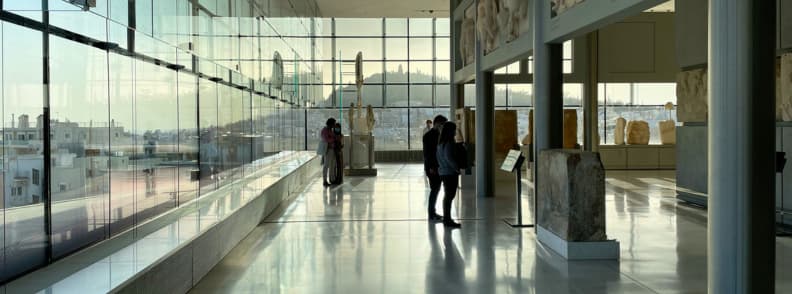
2. Acropolis Museum, Where Ancient Athens Comes to Life
The Acropolis Museum is a must-visit for anyone exploring Athens’ archaeological sites. Just a short walk from the Acropolis, this modern, beautifully designed museum houses some of the most significant ancient artifacts in Greece. With its glass floors revealing excavations beneath, it offers visitors a unique perspective into the city’s past, literally and figuratively. If you want to truly understand the Acropolis, this Athens museum is the place to start.
What to visit in the Acropolis Museum
The Acropolis Museum is designed to showcase the artistic and architectural brilliance of ancient Athens. Each floor reveals a different aspect of the city’s past, leading you on a journey through time and craftsmanship.
1. The Parthenon Gallery, the Masterpiece of Ancient Greece
One of the most breathtaking spaces in the Acropolis Museum, the Parthenon Gallery is designed to replicate the layout of the actual Parthenon Athens. The original sculptures, including fragments of the Parthenon frieze, are displayed in a way that mirrors their original positioning on the temple. As you walk through the bright, open space, you’ll notice how natural light floods the gallery, creating an effect similar to what ancient Athenians would have seen when gazing at these masterpieces atop the Acropolis.
The frieze, a continuous band of sculpted marble that once wrapped around the Parthenon, depicts the Panathenaic Procession, a grand festival held in honor of Athena, the city’s patron goddess. Despite the damage over time (partially due to wars, looting, and weathering), many of the sculptures remain remarkably detailed, allowing you to see the craftsmanship of 5th-century BC Athens up close.
Watch the 3D video on the Parthenon’s history on the third floor. It’s an excellent way to understand the evolution of the Acropolis complex and the significance of its Athens temples.
Pro Tip: Stand near the floor-to-ceiling windows to fully appreciate how the Parthenon sculptures align with the actual Acropolis hill in the background. It’s a deliberate architectural choice that enhances the immersive experience.
2. The Caryatids of the Erechtheion, the Graceful Guardians
The Caryatids, also known as the Maidens of the Erechtheion, are among the most captivating pieces in the Acropolis Museum. These life-sized female figures once stood proudly on the Porch of the Maidens, supporting the Erechtheion’s roof with their finely carved draped garments. Today, only five of the original six Caryatids remain in Athens. The missing one was taken by Lord Elgin in the 19th century and now resides in the British Museum. Seeing them up close allows you to admire the delicate carving of their braided hairstyles, their fluid robes, and the subtle expressions on their faces, all testament to the skill of ancient Greek sculptors.
Little-Known Tip: If you listen closely, you’ll hear the low hum of machines working behind the glass, as the Caryatids undergo a special laser cleaning process to gently remove centuries of pollution without damaging their intricate details.
3. The Archaic Gallery, Athens Before the Parthenon
Long before the golden age of Pericles, Athens was already a flourishing center of art and culture, as evidenced in the Archaic Gallery. This section houses sculptures and reliefs from the 7th to 5th centuries BC, including kouroi (male statues) and korai (female statues) that served as votive offerings or grave markers.
Unlike the white marble statues we typically associate with ancient Greece, many of these figures still bear traces of their original vibrant paint, revealing that Greek temples and sculptures were once adorned in bold reds, blues, and yellows. The level of detail in the carved drapery, facial expressions, and jewelry gives a glimpse into the artistic styles and cultural influences that shaped Athens before the construction of the Parthenon.
Insider Tip: Look for the smiling expressions on many of the Archaic statues. This characteristic Archaic smile was meant to convey vitality and well-being, a stark contrast to the more serious and naturalistic expressions of later classical art.
Plan Your Visit to the Acropolis Museum
The Acropolis Museum is conveniently located at 15 Dionysiou Areopagitou Street, right at the foot of the Acropolis, making it an easy and essential stop for visitors exploring Athens’ ancient sites. Its central location means you can pair your visit with a trip to the Acropolis, the Parthenon, and the Theater of Dionysus, all within walking distance.
The museum café offers a stunning view of the Acropolis. It’s the perfect spot to take a break and enjoy a coffee while admiring the city’s most famous landmark.
The museum is open Tuesday to Sunday from 8 AM to 8 PM, with extended hours on Fridays until 10 PM, allowing visitors to enjoy a more relaxed experience in the evening. Mondays are the only day the museum is closed, so plan accordingly to avoid disappointment.
Allocate at least two hours to explore the museum properly. There’s so much to see, and rushing through won’t do it justice.
Ticket prices range from €5 to €10, depending on the season. Standard admission is €10, while a reduced ticket of €5 is available for certain groups, including EU students. For those looking to visit on a budget, the Acropolis Museum offers free admission on specific days, including 6 and 25 March, 18 May, and 28 October. If you’re visiting during these dates, take advantage of the opportunity to explore one of Athens’ most important museums at no cost.
To celebrate Greece’s National Holiday on 28 October, the Acropolis Museum brings to life the legendary statue of Athena Parthenos, originally crafted from gold and ivory by Phidias for the Parthenon.
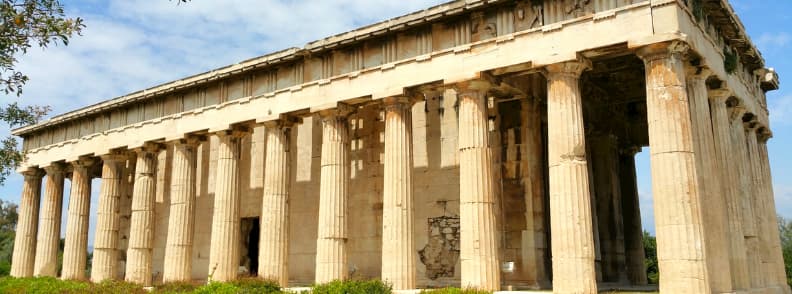
3. The Ancient Agora. Walking in the Footsteps of Socrates
In the heart of Athens, just a short stroll from the buzzing Monastiraki Square, the Ancient Agora is one of the most significant archaeological sites in Athens. Once the political, commercial, and cultural hub of the city, it’s where democracy was born, where Socrates debated, and where Athenians gathered to discuss philosophy, politics, and daily life. Unlike the grandeur of the Acropolis, the Agora offers a tranquil, open-air experience, allowing visitors to explore at a relaxed pace and truly absorb the rich history of ancient Athens.
If you want to experience ancient Athens beyond the Acropolis, the Athenian Agora is a must-visit. Walking through its ruins, you’re following in the footsteps of Plato, Aristotle, and St. Paul, all of whom spent time here. It’s easy to imagine the lively atmosphere of market stalls, public speeches, and political gatherings that once filled this space. Whether you’re a history enthusiast, a casual traveler, or a local looking to rediscover Athens, the Agora is an essential stop.
What to visit in the Ancient Agora Athens
1. Temple of Hephaestus, the Best-Preserved Ancient Greek Temple
Standing tall on the western edge of the Agora, the Temple of Hephaestus is a remarkable example of Doric architecture and one of the best-preserved temples in Greece. Dedicated to Hephaestus, the god of fire, blacksmiths, and craftsmanship, it remains almost intact after more than 2,400 years.
Local Tip: Visit in the late afternoon when the golden sunlight beautifully illuminates the temple’s columns. It’s the perfect time for stunning photos and a peaceful atmosphere away from the midday crowds.
2. Stoa of Attalos, an Ancient Shopping Arcade
Originally built in the 2nd century BC, the Stoa of Attalos was a grand covered walkway, offering shade to merchants and shoppers in the bustling Agora. Today, it has been reconstructed and houses the Agora Museum, where you can see artifacts from the site, including ancient coins, pottery, and everyday objects from classical Athens.
Pro Tip: The cool, shaded interior of the Stoa makes it a great place to take a break from the Athenian heat while learning more about ancient Greek life.
3. The Altar of Zeus Agoraios, a Sacred Offering Site
The Altar of Zeus Agoraios is one of the lesser-known gems of the Agora but played an important role in public religious ceremonies. Dedicated to Zeus Agoraios (Zeus of the Agora), this was a place where Athenians made sacrifices and offerings to seek the god’s protection over public affairs and commerce.
Hidden Gem: While the altar itself is mostly ruins today, its historical significance is immense. This was where politicians, merchants, and philosophers paid homage to Zeus before addressing the public.
4. Basileus Porticle, the Seat of Justice
One of the oldest buildings in the Ancient Agora, the Basileus Porticle was constructed in 500 BC and housed the judicial chancellery of ancient cults. Though most of it was destroyed during the Gothic invasions of 267 AD, the ruins still give a sense of its former grandeur.
The Basileus Porticle was where important legal and religious matters were debated, making it an essential part of the city’s governance.
The best place to see the Basileus Porticle is Adrianou Street. Another reason to visit Adrianou Street is to try traditional Greek food and drinks at one of its many tavernas while admiring Athens archaeological sites.
5. Odeon of Agrippa, a Grand Amphitheater
Built in 15 BC by Marcus Vipsanius Agrippa, the Odeon of Agrippa was a massive amphitheater that could accommodate around 1,000 spectators. Its exterior was once adorned with statues of Giants and mythical creatures, some of which can still be seen today.
Insider Tip: The Odeon is easy to miss! Look for the remaining columns decorated with giant figures, which once supported the grand structure.
6. Tholos, the First Greek Parliament
The Tholos is one of the most fascinating structures in the Agora. This circular building, resembling a beehive, was where the 50 members of the executive committee of Athens’ first parliament lived and worked.
Little-Known Fact: The members of the Tholos were required to be on duty 24/7, meaning that at least one-third of them had to stay overnight in the building at all times.
7. Monument of the Eponymous Heroes Honoring Athens’ Tribes
The Monument of the Eponymous Heroes was an important public display board in ancient Athens. It featured bronze statues of the ten legendary heroes representing the ten tribes of Attica. It served as both a political and military information hub, where citizens could check official decrees and announcements.
Local Tip: Though only the foundation remains, knowing its historical significance makes it easier to picture the bronze figures that once stood there.
8. The Middle Stoa, the Largest Public Building
The Middle Stoa was one of the most imposing buildings in the Agora, covering a large portion of the center. With its two grand hallways lined with columns, it was a major gathering place for trade, politics, and philosophy.
Hidden Detail: The Middle Stoa was built to organize the space in the Agora, dividing the commercial and civic areas.
9. The Nymphaion, a Lost Fountain of Ancient Athens
Built in the 2nd century AD, the Nymphaion was a grand public fountain that once supplied water to the Agora. Despite being largely in ruins today, some of its remains are still visible, though an 11th-century church was later built on top of it.
Little-Known Tip: If you’re interested in ancient water systems, this is one of the oldest known public fountains in Athens.
Plan Your Visit to the Athens Ancient Agora
The Ancient Agora of Athens is located on Adrianou Street, near the bustling Monastiraki Square, making it easily accessible for visitors exploring the city’s historical center. It’s a sprawling site, and you’ll want to take your time wandering through its ruins. A typical visit lasts between 1.5 to 2 hours, but history lovers may want to set aside more time to fully appreciate the Temple of Hephaestus, the Stoa of Attalos, and the other fascinating structures.
The site is open year-round, but operating hours vary by season. During the summer months (April to October), the Agora welcomes visitors from 8 AM to 8 PM, offering plenty of time to explore under the long daylight hours. In the winter season (November to March), hours are reduced, with entry available from 8:30 AM to 3 PM, so plan accordingly if visiting during these months.
Admission to the Ancient Agora costs €8 for a standard ticket, while reduced entry (€4) is available for eligible visitors. If you plan to visit multiple archaeological sites in Athens, the Athens Archaeological Sites Pass (€30) is a fantastic option. This pass grants access to six top Athens historical sites, including the Acropolis, Roman Agora, and the Temple of Olympian Zeus, making it a cost-effective choice for those exploring more than one location.
Is the Athens Combo Ticket Worth It? Absolutely! If you’re visiting at least two or more of Athens’ archaeological sites, this multi-site pass quickly pays for itself, saving both money and time spent purchasing separate tickets.
For budget-conscious travelers, the Ancient Agora offers free entry on select days throughout the year. The most notable free admission days include the first Sunday of each month (from November to March) and certain national holidays (6 March, 18 April, 18 May, the last weekend of September, and 28 October). Always check official schedules ahead of time, as these dates can vary slightly each year.
If you’re looking for a peaceful escape from the busy streets of Athens, the Ancient Agora is the perfect place to sit on a shaded bench, read a book, and take in the surroundings. Unlike the Acropolis, which can be overwhelmingly crowded, the Agora feels spacious and relaxed, making it a fantastic spot to experience Athens’ ancient history without the chaos.
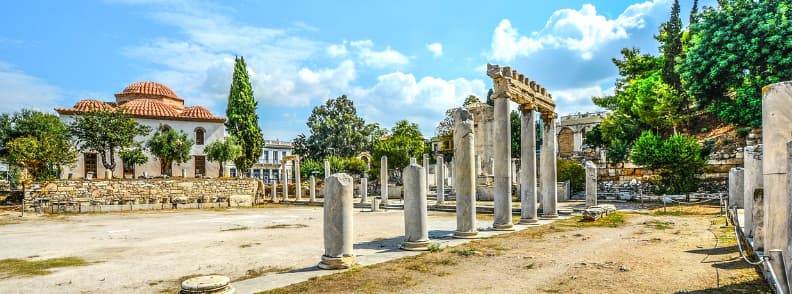
4. Roman Agora & Hadrian’s Library, Part of Athens Roman Heritage
Tucked between the busy streets of Monastiraki and the grandeur of the Ancient Agora, the Roman Forum or Roman Agora of Athens is an underrated yet fascinating site that transports you back to the days of Roman rule. While many travelers rush to see the Acropolis and Ancient Agora, this historic marketplace often remains blissfully uncrowded, making it a perfect stop for those who love history without the crowds.
Whether you’re a first-time visitor eager to explore Athens’ ancient sites or a history enthusiast looking to uncover lesser-known gems, this guide will walk you through the must-see landmarks, hidden details, and pro tips to help you experience the Roman Agora like a local.
Built in the 1st century BC, the Roman Agora replaced the Ancient Agora as the city’s commercial hub under Roman rule. Funded by none other than Julius Caesar and Emperor Augustus, this marketplace flourished with merchants, public buildings, and administrative offices. While it’s smaller than the Ancient Agora, it still holds incredible historical significance and features some of the best-preserved Roman ruins in Athens.
What to Visit in the Roman Agora of Athens
1. Tower of the Winds, the World’s First Meteorological Station
One of the most fascinating landmarks in the Roman Agora is the Tower of the Winds, an ancient octagonal clocktower built in 50 BC by the astronomer Andronikos Kyrrhestas. This structure is considered the world’s first meteorological station, featuring sundials, a water clock, and wind indicators on each of its eight sides, each representing a different wind deity. Over the centuries, it has served as a clock tower, a church, and even a dervish lodge during Ottoman rule.
Photography Tip: The Tower of the Winds looks stunning when lit by the golden hour sunlight.
An overlooked yet fascinating feature of the site is the Byzantine funerary decorations surrounding the Tower of the Winds. The tower was later used as a church in Athens, and the area around it became a Christian cemetery, with beautifully carved tombs and burial markers. Some of these remains were later relocated to this site from other parts of the city.
Insider Tip: Stand back and observe the tower’s intricate carvings representing each of the eight winds. It’s a rare example of ancient scientific knowledge blending with art.
2. Hadrian’s Library, a Roman Emperor’s Gift to Athens
Emperor Hadrian, a known admirer of Greek culture, built Hadrian’s Library in AD 132. This grand Corinthian-style structure was a library in Athens, a cultural and intellectual hub with reading rooms, music halls, a theater, lush gardens, and even a pool.
Insider Tip: Stand near the ruins of the grand entrance and picture the scholars and philosophers who once studied here.
3. Gate of Athena Archegetis, the Grand Entrance to the Agora
The Gate of Athena Archegetis, an imposing marble gateway built in 11 BC, once served as the grand entrance to the Roman marketplace. Dedicated to Athena Archegetis, the patron goddess of Athens, the gate was funded by Julius Caesar and Augustus, as noted in the inscription above the entrance. It remains one of the best-preserved structures on the site, standing as a symbol of Roman influence in Athens.
Insider Tip: Look closely at the gate’s ancient inscriptions, which mention Athens’ Roman benefactors.
4. Vespasianae, the Ancient Public Toilets
An unusual but intriguing part of the Roman Agora is the Vespasianae, or public latrines., offering a rare glimpse into Roman sanitation. This rectangular building with an interior courtyard housed 68 toilets, arranged along the walls. In ancient Roman times, public toilets were social hubs where citizens gathered to chat, discuss politics, and exchange news.
Fun Fact: Romans used shared sponges on sticks instead of toilet paper. Something to think about while appreciating modern-day conveniences!
5. Fethiye Mosque, an Ottoman Legacy in the Agora
The Fethiye Mosque is a reminder that even under Ottoman rule, the Roman Agora remained a vital part of Athenian life. Constructed in 1456 on the ruins of an early Christian church, this mosque has recently been restored and is occasionally used for exhibitions.
Pro Tip: If you’re visiting on a clear day, the mosque’s pastel-colored façade looks stunning against the Athenian sky, perfect for photos!
6. The East Propylon, One of the Original Entrances
The East Propylon was one of two original entrances into the Roman Agora. Near the East Propylon, you can find ancient sculptures of important Roman citizens, adding yet another layer of historical significance to the site.
7. The Agoranomeion, the Office of the Administrators
The Agoranomeion, once the office of the administrators of the Agora, is where officials managed market regulations. It played a vital role in the market’s economic and political operations.
Pro Tip: If you’re fascinated by ancient trade and economy, this small but significant building is worth a closer look.
8. The Agora’s Central Yard, a Roman Shopping Hub
At the heart of the Roman Agora, a large paved courtyard once hosted various market stalls and shops. In the 2nd century AD, under Emperor Hadrian, the courtyard underwent renovations and became a busy commercial hub.
Local Tip: Stand in the center and imagine this Athens marketplace alive with merchants, traders, and shoppers from all over the Roman Empire.
Today, the Roman Agora isn’t just a historical landmark. It’s a place where past and present merge, offering a glimpse into the daily life of ancient Athens.
Plan Your Visit to the Roman Agora of Athens
The Roman Agora is conveniently located at Aiolou & Diogenous Streets in the lively Monastiraki district, making it an easy stop while exploring central Athens’ archaeological sites. Its proximity to other historic landmarks, like the Ancient Agora and Hadrian’s Library, makes it a perfect addition to any itinerary.
The site is open daily, with summer hours (April-October) from 8 AM to 8 PM and winter hours (November-March) from 8 AM to 5 PM. It’s best to visit early in the morning or late afternoon to enjoy the ruins without the midday heat.
Agora tickets cost €6 per person, with a reduced rate of €3 available for eligible visitors. If you’re planning to visit multiple archaeological sites in Athens, consider purchasing the Athens Archaeological Sites Pass (€30), which grants access to the Acropolis, Ancient Agora, Roman Agora, Hadrian’s Library, Temple of Olympian Zeus, and Kerameikos.
For those looking to explore Athens on a budget, the Roman Agora offers free entry on the first Sunday of the month from November to March. If you’re in town during this period, it’s a great opportunity to see the site at no cost while enjoying a quieter, less touristy atmosphere.
Little-Known Tip: If you happen to be in Athens during late August, the Harvest Moon classical music concert held inside the Agora is a truly unforgettable experience.
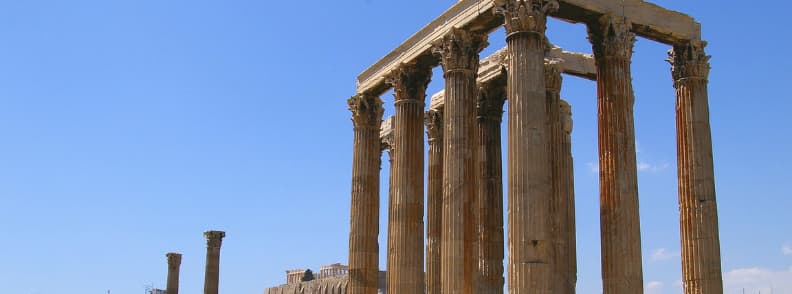
5. Temple of Olympian Zeus, a Majestic Ruin in the Heart of Athens
The Temple of Olympian Zeus is one of Athens’ most awe-inspiring ancient ruins, a place where sheer size and historical significance come together. Once the largest temple in Greece, it was a monumental tribute to Zeus, the king of the gods. Today, only a handful of its towering Corinthian columns remain standing, yet they still offer a glimpse into its former grandeur.
This ancient site in Athens is a must-visit, not just for its impressive ruins but also for its hidden gems, including the best-preserved Roman baths in the city and remnants of long-lost Greek temples. Nestled between the Acropolis and Syntagma Square, it’s easy to fit into any Athens itinerary, whether you’re a first-time visitor or a history-loving local rediscovering your city.
Construction of the Temple of Olympian Zeus began in the 6th century BC, but due to political turmoil, it remained unfinished for over 600 years. It wasn’t until Emperor Hadrian took over Athens in AD 131 that the temple was finally completed. At its peak, it stood as a massive structure with 104 Corinthian columns, each 17 meters high, supporting an enormous roof. Inside, there were colossal statues of Zeus and Hadrian, symbolizing both Greek religion and Roman power.
Sadly, after centuries of invasions, natural disasters, and material repurposing, only 15 columns remain standing, with one more lying where it fell during a storm in 1852. Yet, despite its ruined state, this archaeological site in Athens remains a breathtaking testament to ancient architecture and ambition.
What to Visit at the Temple of Olympian Zeus
While most visitors focus on the gigantic columns, there’s much more to explore around the temple grounds. Here are some lesser-known but equally fascinating highlights:
1. Hadrian’s Arch, the Gateway Between Two Eras
Just outside the Temple of Olympian Zeus, Hadrian’s Arch marks the divide between ancient Athens and the Roman city of Hadrian. Built in AD 131, this iconic landmark symbolizes Athens’ transition from Greek mythology to Roman rule.
Look closely at the two inscriptions: facing the Acropolis, it reads This is Athens, the ancient city of Theseus, honoring the city’s Greek roots. The other side, directed toward the Roman quarter, states This is Hadrian’s city, not Theseus’s, asserting Hadrian’s influence.
This archaeological site in Athens offers a great photo spot, perfectly framing the Acropolis in the background. If you’re using the Athens Archaeological Sites Pass, stop here before entering the Temple of Olympian Zeus. It’s free to visit!
Stand in the middle of the arch and see how it frames the Acropolis in one direction and modern Athens in the other. It’s a perfect metaphor for the city’s evolution.
2. The Roman Baths, a Hidden Gem in Athens
Tucked away among the remains of Hadrianopolis, the city built by Roman Emperor Hadrian, lies one of the best-preserved Roman baths in Athens. These ancient bathhouses were once a hub of daily life, where Athenians gathered to relax, socialize, and cleanse. Originally adorned with intricate mosaics and marble flooring, the baths reflected the lavish lifestyle of Roman-era Athens, showcasing the city’s blend of Greek and Roman influences.
Despite their historical significance, these Roman baths in Athens often go unnoticed by tourists, making them an ideal hidden gem for those looking to escape the crowds. If you’re fascinated by ancient engineering and Roman architecture, this site is definitely worth a visit. Walking through the remains, you can still spot traces of the original heating system, a testament to the advanced technology of the Roman Empire.
3. The Valerian Wall from a Fortified Past
Along the perimeter of the Temple of Olympian Zeus, you’ll find the remains of the Valerian Wall, a defensive barrier constructed in the 3rd century AD under Emperor Valerian. Built in response to growing threats from barbarian invasions, this wall was an attempt to fortify Athens during a period of instability. However, its construction came at a cost and several ancient temples in Athens were demolished, and their marble was repurposed to build the wall.
Take a closer look at the stonework, and you’ll notice an intriguing detail: many of the marble blocks still bear ancient inscriptions, revealing their original purpose before being reused in the wall. This mix of architectural elements provides a unique insight into Athens’ layered history, where Greek archaeological sites were often reshaped and rebuilt to adapt to changing times.
4. The Temple of Apollo Delphinios and Artemis Delphinia
Near the Valerian Wall, the Temple of Apollo Delphinios and Artemis Delphinia may not be the most visually striking of Athens ancient sites, but its spiritual significance in Greek history is undeniable. Dedicated to Apollo and Artemis in their dolphin forms, the temple symbolized their connection to the sea and protection of sailors. While little remains today, this archaeological site in Athens once played a vital role in religious rituals. If you’re exploring the Temple of Olympian Zeus and the Valerian Wall, take a moment to reflect on the deep-rooted mythology tied to this spot, proof that even the smallest ruins in ancient Athens hold great stories.
5. Delphinion Law Court, When Myth Meets Reality
Located adjacent to the Temple of Apollo Delphinios, this 5th-century BC site is believed to have once been the palace of King Aegeus, the legendary father of Theseus. Over time, it evolved into an important law court, where major political and legal decisions were made in ancient Athens.
This site is particularly significant because it ties into one of the most famous Athenian tragedies. According to myth, King Aegeus mistakenly believed that his son Theseus had died during his quest to slay the Minotaur. Overcome with grief, he leapt into the sea, giving the Aegean Sea its name. This dramatic story is forever linked to this historic location, making it a must-visit for those interested in both Greek mythology and ancient Athenian law.
6. Temple of Cronus and Rhea, a Forgotten Sanctuary
At the far end of this Athens site, The Temple of Cronus and Rhea was a significant Greek archaeological site in Athens, dedicated to Zeus’ parents, Cronus and Rhea. Built in the 5th century BC, this temple once played a central role in ancient Athenian religious life. Though only its foundation remains today, it was once a prominent sanctuary, reflecting the deep-rooted mythology and worship of the Titans in Athens. While exploring the Temple of Olympian Zeus, take a moment to visit this often-overlooked site to appreciate its connection to Athens’ ancient past.
Plan Your Visit to the Temple of Olympian Zeus
The Temple of Olympian Zeus is located on Leoforos Vasilisis Amalias in the heart of Athens, making it an easy stop while exploring the city’s archaeological sites. The site is open daily, with summer hours (April to October) from 8 AM to 8 PM, while in winter (November to March), it closes earlier at 3 PM. A visit typically takes around 30 to 45 minutes, depending on how much time you spend admiring the towering columns and surrounding ruins.
Pro Tip: The best time to visit is late afternoon (3-4 PM) when the sunlight beautifully illuminates the columns, making for stunning golden-hour photos. Plus, the site is less crowded, offering a peaceful experience.
Entry costs €6 for a general ticket and €3 for a reduced ticket, but if you plan to visit multiple ancient sites in Athens, it’s worth considering the Athens Archaeological Sites Pass (€30), which includes access to several major landmarks. If you’re looking to visit for free, mark your calendar for the first Sunday of the month from November to March, Greek national holidays, or International Museum Day (18 May) when admission is free.
The Temple of Olympian Zeus might not be as intact as the Acropolis, but its monumental scale and fascinating history make it a must-see archaeological site in Athens. From Hadrian’s influence on the city to the hidden gems within the ruins, this spot offers a unique blend of Greek and Roman heritage.
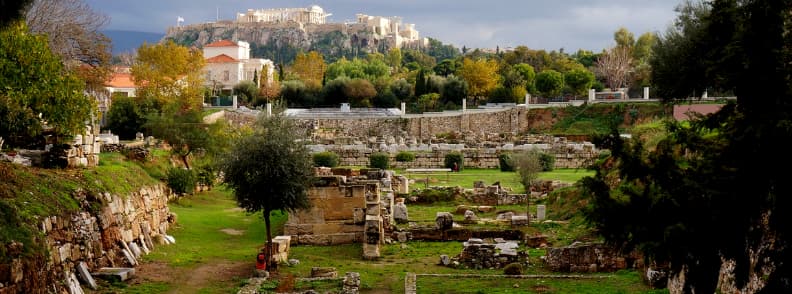
6. Kerameikos, the Ancient Cemetery of Athens
When people think of Athens’ ancient sites, the Acropolis, the Parthenon, and the Ancient Agora often take the spotlight. But if you’re looking for a hidden gem, a place where history, art, and archaeology intertwine in a peaceful setting, Kerameikos is where you should go.
This less-visited archaeological site was once the main burial ground of ancient Athens, a sacred space where prominent Athenians were laid to rest. Walking through Kerameikos, you’re not just visiting an old cemetery. You’re stepping into a space filled with stories of ancient warriors, revered families, and everyday Athenians who shaped the city we know today.
Here’s everything you need to know before visiting Kerameikos, from its famous Athens monuments to local tips that will enhance your experience.
What to Visit in the Kerameikos
Unlike the Acropolis or the Ancient Agora, Kerameikos offers a serene escape from the crowds, yet it is just as significant in Athens’ history. Here, you’ll find:
1. The City Walls, a Story of Athenian Resilience
Built in 478 BC by Themistocles, the city walls were constructed in a hurry after the Persian invasion. Due to time constraints, the builders used anything they could find, including marble from Athens temples and gravestones from older burials. Today, you can still see fragments of inscriptions and sculptures embedded in the walls, a silent testament to Athens’ ability to rebuild itself from destruction.
Pro Tip: Look closely at the walls. You might spot pieces of old funerary monuments reused in the construction!
2. Dipylon Gate, the Grand Entrance to Ancient Athens
This was the largest and most important gate in ancient Athens, marking the beginning of the Sacred Way leading to Eleusis. It was here that travelers, traders, and dignitaries entered the city. It was also the site of public funerals for Athenian war heroes, with Pericles himself delivering famous speeches here.
Local Insight: The Dipylon Gate was also the starting point for the Panathenaic Procession, where Athenians carried a new robe (peplos) to the statue of Athena on the Acropolis.
3. The Sacred Gate, a Pathway for Pilgrims
Unlike the Dipylon Gate, which was used for general passage, the Sacred Gate was reserved for religious ceremonies and priestesses on their way to the Eleusinian Mysteries. This was one of the most mystical religious festivals in ancient Greece, celebrating the goddess Demeter and the cycle of life and death.
Pro Tip: Stand at the Sacred Gate and imagine the ancient processions of pilgrims, dressed in white robes, carrying torches as they walked toward Eleusis.
4. Pompeion, the Headquarters of Athenian Festivities
The Pompeion was the main gathering space for preparations before religious processions, particularly the Panathenaic Festival. This was where the elaborate peplos for Athena was woven and stored before being presented at the Parthenon.
Little-Known Fact: The Pompeion was also used for banquets and cultural gatherings, making it one of the most socially significant buildings in Athens.
5. Kerameikos Archaeological Museum, a Must-Visit
This small but impressive museum houses many of the original artifacts excavated from Kerameikos, including painted funerary vases, sculptures, and jewelry found in tombs. One of the most surprising discoveries? Ceramic fragments illustrating scenes from ancient Athenian brothels!
Personal Tip: Don’t skip the Grave Stele of Hegeso inside the museum. It’s one of the most exquisite funerary reliefs from 5th-century BC Athens.
6. The Marble Bull, an Iconic Tomb Monument
This impressive marble sculpture sits atop the tomb of Dionysos of Kollytos, a man so admired that he was said to be worshipped like a god. The inscriptions on the tomb tell us that he died a bachelor, mourned deeply by his mother and sisters.
Pro Tip: The bull is located in one of the most photogenic spots in Kerameikos, especially in the soft light of sunset.
7. The Grave Stele of Hegeso, a Touching Scene from Ancient Greece
This beautiful funerary relief, dating back to 410 BC, shows Hegeso, a wealthy Athenian woman, admiring a small jewel in her hand while her servant waits nearby. It’s a poignant reminder of how even the wealthiest Athenians prepared for the afterlife.
Where to See It: The original is preserved in the National Archaeological Museum, while a faithful replica stands at the Kerameikos site.
8. The Tritopatreion Sanctuary Honoring the Ancestors
This lesser-known sanctuary was a sacred gathering place where Athenians worshipped their common ancestors. Located at the crossing of the Sacred Way and the Tombs Way, it’s one of the most spiritually significant sites in Kerameikos.
Local Insight: If you’re interested in ancient Greek spirituality, this site provides a rare glimpse into ancestor worship in Athens.
Plan Your Visit to Kerameikos
Kerameikos is located at Ermou 148, Thissio district, making it easily accessible for visitors exploring Athens’ archaeological sites. The site operates on seasonal hours, opening from 8 AM to 8 PM during the summer months (April to October) and from 8:30 AM to 3 PM in the winter (November to March).
My Advice: Visit late in the afternoon to catch the sunset light on the ruins. This is one of the most peaceful and magical moments you’ll experience in Athens.
To fully appreciate the site and its historical significance, plan to spend 1 to 2 hours wandering through the ancient cemetery, city walls, and museum, soaking in the rich history and peaceful atmosphere.
Admission fees are quite affordable, with a standard Kerameikos ticket costing €8 and a reduced rate of €4 for eligible visitors. If you’re planning to visit multiple ancient sites, the Athens Archaeological Sites Pass (€30, valid for 5 days) is a great option, granting access to several key locations, including the Acropolis, Ancient Agora, and Temple of Olympian Zeus.
For those looking to explore Kerameikos for free, there are several free entrance days throughout the year. Visitors can enjoy complimentary access on the first Sunday of the month from November to March, as well as on special occasions such as 6 March, 18 April, 18 May, and 28 October.
Kerameikos is one of the most underrated archaeological sites in Greece. It gives you a glimpse into Athenian life and death, with fascinating sculptures, ancient roads, and lesser-known Athens monuments that provide a different perspective on the city’s history. If you love history and archaeology, or just want to escape the crowds, this is a must-visit ancient site in Athens.
7. Aristotle’s School (Lyceum), a Walk Through Philosophical History
In the heart of Athens lies the remnants of Aristotle’s Lyceum, a site that once buzzed with intellectual fervor and philosophical debates. Established in 335 BC by Aristotle himself, this institution wasn’t just a school; it was the birthplace of the Peripatetic school of philosophy, where walking and talking went hand in hand.
The term Lyceum originates from the temple dedicated to Apollo Lyceus (Apollo the Wolf-God), which is located nearby. Before Aristotle’s tenure, the area served as a gymnasium, a place for both physical and intellectual exercise. When Aristotle returned to Athens, he transformed this space into a center for learning, where he and his students would engage in discussions while strolling through the grounds, leading to the moniker Peripatetic, derived from the Greek word for walking.
The Lyceum also encompassed studies in natural sciences, politics, and ethics, making it a multifaceted institution of its time. Aristotle’s teachings here laid the foundation for many disciplines we recognize today.
Rediscovered in 1996 during excavations for Athens’ Museum of Modern Art, the archaeological site of Aristotle’s Lyceum offers visitors a tranquil escape from the city’s hustle and bustle. Located near the intersection of Rigillis and Vasilissis Sofias streets, adjacent to the National Garden, the site provides a serene environment to reflect upon the philosophical giants who once walked its grounds.
Plan Your Visit to the Lyceum in Athens
Aristotle’s Lyceum is open daily, allowing visitors to explore this historic site at their convenience. During the summer months, the site operates from 8:00 AM to 8:00 PM, with the last entrance permitted at 7:40 PM. In the fall and winter months, the schedule may vary, so it’s always a good idea to check the official website for up-to-date opening hours before your visit.
Entry to Aristotle’s School is affordable, with a full Lyceum ticket costing €4 and a reduced ticket available for €2. No advance reservation is required, making it easy for spontaneous visits. Additionally, the site offers free entry on 6 March, 18 April, 18 May, the last weekend of September, and 28 October.

8. Areopagus Hill (Mars Hill), a Place of Legends and Justice
Located just northwest of the Acropolis, Areopagus Hill, also known as Mars Hill Athens, is a site steeped in mythology, history, and philosophy. In ancient times, this rocky outcrop served as the Supreme Court of Athens, where cases of homicide, religious matters, and even political crimes were judged. It is also famous in Christian history, as it was here that St. Paul delivered his sermon to the Athenians in 49 AD, introducing Christianity to Greece.
Today, Areopagus Hill is a favorite viewpoint for visitors wanting to take in breathtaking panoramic views of Athens, including the Acropolis, Ancient Agora, and cityscape stretching toward Piraeus. The rock itself is rugged and uneven, so caution is needed when climbing, especially since it can be slippery.
What to Visit on Areopagus Hill or Mars Hill Athens
1. The Rock of Areopagus
The main rocky outcrop of Areopagus Hill (Mars Hill Athens) is where the ancient court once held its most significant trials. In classical Athens, this was the meeting place of the Areopagus Council, the city’s highest judicial authority, responsible for overseeing cases of homicide, religious disputes, and serious crimes. Walking on this historic ground, you’re standing where some of the most important legal and political decisions of ancient Athens were made.
2. St. Paul’s Bronze Plaque, a Testament to Athens’ Religious History
Near the foot of Areopagus Hill (Mars Hill Athens), visitors will find St. Paul’s Bronze Plaque, an inscribed tribute to one of the most significant moments in Christian history. This plaque commemorates the speech given by St. Paul to the Athenians in 49 AD, where he addressed the city’s philosophers about the “Unknown God.”
The inscription on the plaque features an excerpt from St. Paul’s Areopagus Sermon, as recorded in the Book of Acts (17:22-31). In his speech, he introduced Christian teachings to a city deeply rooted in Greek mythology and polytheism, emphasizing the idea of one true God rather than multiple deities. This moment marked an important step in the spread of Christianity in Greece.
Today, the St. Paul’s Bronze Plaque stands as a powerful reminder of Athens’ religious and philosophical diversity. It attracts both history enthusiasts and Christian pilgrims who wish to reflect on the impact of this speech. If you’re exploring archaeological sites in Athens, stopping by this plaque offers a unique opportunity to connect with the spiritual and intellectual history of the city.
3. The Staircase to the Acropolis
One of the most historic routes in Athens, the ancient stone steps connecting Mars Hill Athens to the Acropolis are still visible today. These steep and uneven stairs once served as a direct path for Athenians making their way to the sacred hill, where the Parthenon and other archaeological sites in Athens stand.
Although the staircase offers a unique way to experience ancient Athens sites, caution is needed when climbing. The worn marble surface can be slippery, especially after rain, making sturdy footwear essential. If you’re exploring Athens’ archaeological sites, taking this historic route adds an extra layer of authenticity to your visit.
4. Scenic Viewpoints
One of the best free viewpoints in Athens, Areopagus Hill (Mars Hill Athens) offers stunning panoramic views of the city’s most famous landmarks. Whether you’re visiting at sunrise or sunset, this spot is a photographer’s dream, with the golden light casting a magical glow over the Athens ancient ruins.
From the top, you get an unparalleled view of the Acropolis and Parthenon, standing majestically over the city. To the northwest, you’ll see the Ancient Agora, once the center of political and social life in ancient Athens. Just beyond it, the Temple of Hephaestus, one of the best-preserved Greek temples, comes into view. Looking toward the west, Pnyx Hill, the birthplace of Athenian democracy, adds another layer of history to this breathtaking scene.
5. Hidden Caves & Small Ruins
Scattered along the sides of Areopagus Hill (Mars Hill Athens), you’ll find hidden caves and small ruins that hint at the area’s ancient past. These natural rock formations and remnants of ancient altars are believed to have played a role in religious ceremonies during pre-classical Athens.
Archaeologists suggest that these sites may have been used for offerings and rituals long before the golden age of Athens, adding another layer of mystery to this historic archaeological site in Athens. While often overlooked, these hidden spots provide a fascinating glimpse into the early spiritual practices of the city.
Wear proper footwear. The rock is smooth and slippery, especially after rain.
Plan Your Visit to Areopagus Hill
Areopagus Hill is located just northwest of the Acropolis, near the main entrance to the Acropolis of Athens. It is easily accessible from Dionysiou Areopagitou Street and is a short walk from Monastiraki, Plaka, and the Ancient Agora.
Unlike most archaeological sites Athens, Areopagus Hill is open 24/7, allowing visitors to explore it at any time of the day or night. Most visitors spend around 20 to 40 minutes exploring Mars Hill Athens. If you want to enjoy the panoramic views, take photos, or sit and reflect, you might want to stay longer, especially at sunset when the city lights begin to glow.
Bring a flashlight if you’re staying after sunset, the area has minimal lighting.
Areopagus Hill entrance fee is zero, it’s completely free to visit. Unlike the Acropolis or other Athens ancient sits, there is no entrance fee, making it a great stop for budget travelers. It’s also an excellent alternative viewpoint if you don’t want to pay for the Acropolis entrance ticket but still want stunning views of Athens’ ancient sites.
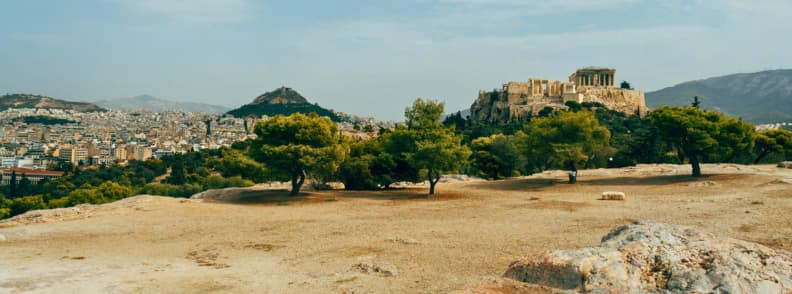
9. Pnyx Hill, the Birthplace of Democracy
Just a short walk from Areopagus Hill (Mars Hill Athens) lies Pnyx Hill, one of the most historically significant archaeological sites in Athens. This unassuming hill was the political heart of ancient Athens, where citizens gathered to practice direct democracy, making it the world’s first official meeting place for free speech and civic debate.
From the 5th century BC, the Athenian Assembly (Ekklesia) met here to discuss and vote on important state matters. This is where great orators like Pericles, Themistocles, and Demosthenes delivered powerful speeches that shaped Greek democracy. The semi-circular auditorium, carved into the rock, could accommodate up to 6,000 citizens, all of whom had the right to vote on laws and policies.
What to Visit on Pnyx Hill
1. The Speaker’s Platform (Bema)
At the heart of Pnyx Hill, you’ll find the Speaker’s Platform (Bema), a large stone podium where political leaders and philosophers once stood to address the Athenian citizens. This was the very spot where democracy was put into practice, as influential figures like Pericles, Themistocles, and Demosthenes delivered speeches that shaped the future of ancient Athens. Standing here today, you can almost imagine the passionate debates that once echoed through the assembly.
2. Terraced Seating Area
Surrounding the platform is the terraced seating area, which showcases the three phases of construction that the site underwent as Athenian democracy evolved. Originally a simple gathering space, the area was later expanded and reinforced with stone walls and seating arrangements to accommodate the growing number of citizens participating in the democratic process. The ruins visible today are a testament to the importance of Pnyx Hill in shaping the political landscape of ancient Greece.
3. Panoramic Views
Beyond its historical significance, Pnyx Hill is also one of the best free viewpoints in Athens. From here, visitors can enjoy panoramic views of the Acropolis, the Parthenon, and the Athens cityscape, making it a fantastic spot for photography and quiet reflection. Like Areopagus Hill (Mars Hill Athens), Pnyx Hill provides a peaceful retreat from the crowds while offering an unparalleled perspective on the ancient sites of Athens.
Plan Your Visit to Pnyx Hill
Pnyx Hill is located west of the Acropolis, near Areopagus Hill (Mars Hill Athens) and the Philopappos Monument. It is easily accessible from Dionysiou Areopagitou Street and can be reached on foot from the Ancient Agora or Monastiraki. The hill offers a quiet, historical escape with stunning views of some of the most famous ancient sites in Athens.
Combine with a visit to Areopagus Hill and the Acropolis. They are all within walking distance.
Unlike many archaeological sites in Athens, Pnyx Hill is open 24/7, allowing visitors to explore it at any time of day or night. It’s an ideal spot for an early morning visit or a peaceful sunset experience. Visiting in the morning or late afternoon will also help you enjoy the site in cooler temperatures.
A major advantage of visiting Pnyx Hill is that it’s entirely free. Unlike the Acropolis and other Athens archaeological sites, there’s no entrance fee, making it a fantastic budget-friendly option for history enthusiasts.

10. Philopappos Hill, the Hill of the Muses with Best Views of Athens
Southwest of the Acropolis lies Philopappos Hill, also known as the Hill of the Muses, a pine-covered retreat that offers some of the most breathtaking views over Athens. Named after Gaius Julius Antiochus Philopappos, a Roman senator and great benefactor of the city, the hill combines natural beauty with significant historical interest. For centuries, Athenians have come here for quiet walks, political gatherings, and panoramic views that stretch from the Acropolis to the Saronic Gulf.
What to Visit on Philopappou Hill
At the summit stands the Philopappos Monument, a grand tomb built in the 2nd century AD to commemorate Philopappos. Along the winding paths, visitors can explore the site known as Socrates’ Prison, traditionally believed to be where the philosopher was held before his execution, and the Church of Agios Dimitrios Loumbardiaris, a 15th-century Byzantine chapel with well-preserved frescoes. These stops provide a fascinating mix of classical, Roman, and Byzantine layers of history, all in one walk.
Although the Acropolis often steals the spotlight, Philopappos Hill offers a different perspective. From its pathways and clearings, you can enjoy some of the most striking views of the Parthenon, especially in the soft light of early morning or late afternoon.
Planning Your Visit to Philopappos Hill
Philopappos Hill is freely accessible at all times and does not require a ticket. The most convenient way to reach it is by taking the metro to Thissio Station on the Green Line and walking uphill for about fifteen minutes. Depending on your pace and interest, allow at least one to two hours to explore the hill, taking time to enjoy the historical landmarks and the views. A little-known tip is to visit at sunset for a peaceful and photogenic experience, as this is when the crowds are gone and the Acropolis glows in golden light.
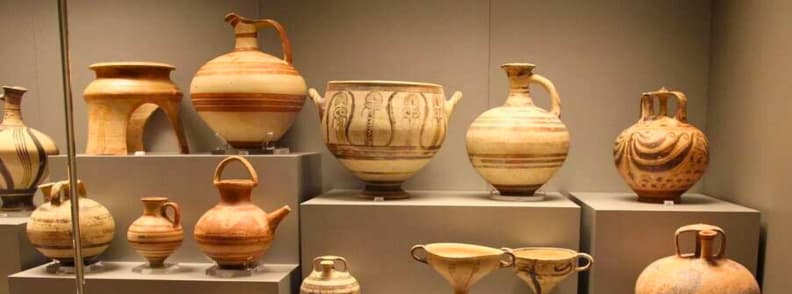
11. National Archaeological Museum, The Heart of Greek Antiquity
The National Archaeological Museum is the largest and most important museum in Greece, housing one of the world’s greatest collections of ancient Greek art. Its neoclassical building, constructed in the late 19th century, was originally designed to display finds from Athens’ urban excavations. Over time, the National Archaeology Museum collection expanded to include artifacts from across Greece, turning it into a treasure trove that chronicles the evolution of Greek civilization from prehistory to late antiquity. This is the place to understand the depth and richness of archaeological sites in Greece, all under one roof.
What to Visit in National Archaeological Museum Athens
The museum’s Prehistoric Collection showcases Cycladic, Minoan, and Mycenaean art, including the world-famous Mask of Agamemnon. Its Sculpture Collection presents masterpieces from the Archaic, Classical, and Hellenistic periods, such as the Jockey of Artemision, a striking bronze statue that brings ancient history to life.
The Vases and Minor Arts section offers a look at beautifully decorated pottery and small objects that provide insight into the daily lives of ancient Athenians. The museum also surprises visitors with an Egyptian Collection, featuring mummies, statues, and artifacts that illustrate Greece’s cultural connections with the wider ancient world.
A little-known highlight is the collection of frescoes from Akrotiri, which offers a rare and colorful glimpse into Bronze Age Aegean life. This section often gets overlooked by rushed visitors, but it is one of the most vivid windows into the ancient past.
Plan Your Visit to the National Archaeological Museum
The National Archaeological Museum is located at 44 Patission Street, easily reached by a ten-minute walk from Omonia Metro Station, served by both the Red and Green lines. Public buses also stop nearby, making it accessible from most areas of Athens.
From April to October, it is open Tuesday to Sunday from 8 AM to 7:30 PM and on Mondays from 12:30 PM to 7 PM. From November to March, it operates Tuesday to Sunday from 8:30 AM to 3 PM and on Mondays from 1:30 PM to 8 PM.
National Archaeological Museum tickets cost €12 in the high season and €6 in the low season, with free admission on the first Sunday of each month between November and March and on designated cultural days. To fully appreciate the museum, set aside at least two to three hours. If you are visiting during the busiest months, consider arriving early to enjoy a quieter experience.
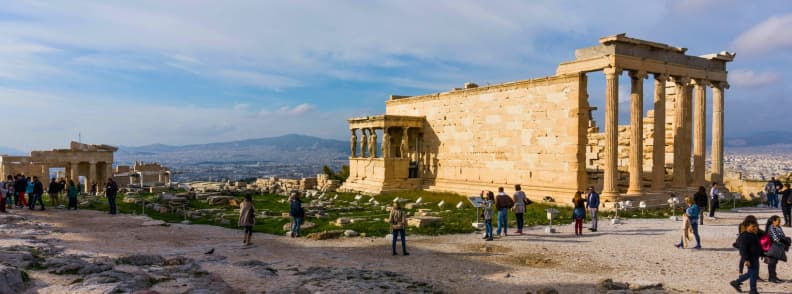
Athena Combined Ticket. The Athens Archaeological Sites Pass
If you’re planning to immerse yourself in the rich history of Athens, the Athens Archaeological Sites Pass is an invaluable asset. This combined ticket offers access to several of the city’s most significant ancient landmarks, providing both convenience and cost savings for history enthusiasts.
What’s Included in the Athens Archaeological Pass?
The pass grants entry to 7 archaeological sites Athens:
- Acropolis of Athens & Slopes with the iconic Parthenon, Erechtheion, and other ancient structures atop the sacred hill.
- Ancient Agora, once the heart of public life, it includes the well-preserved Temple of Hephaestus.
- Roman Agora, is a marketplace reflecting the city’s Roman period, featuring the Tower of the Winds.
- Temple of Olympian Zeus (Olympieion), one of the largest temples of the ancient world, dedicated to the king of the Olympian gods.
- Hadrian’s Library, established by Roman Emperor Hadrian, once housed a vast collection of scrolls.
- Kerameikos, the ancient cemetery of Athens, offering insights into burial customs and city defenses.
- Aristotle’s School (Lyceum), the philosophical school founded by Aristotle, where many of his teachings were developed.
This comprehensive access allows visitors to dive deep into Athens’ ancient past, experiencing a wide array of Athens historical sites without purchasing separate tickets.
Validity and Pricing
The pass is valid for five consecutive days starting from the first day of use, offering ample time to explore each site at a leisurely pace. As of 2025, the standard price for the pass is €30, with reduced rates available for eligible visitors.
Starting April 1st, 2024, the Acropolis of Athens requires all visitors to select a specific time slot when purchasing tickets. Entry is permitted from 15 minutes before to 15 minutes after the chosen time. It’s advisable to arrive 30 minutes prior to your scheduled entry to allow for security checks and ticket validation. For those with the Athens Archaeological Sites Pass, the timed entry requirement applies only to the Acropolis & Slopes. The other sites included in the pass can be visited at any time within the five-day validity period. Visitors are allowed to enter up to 20 minutes before the site’s closing time.
Pro Tip: Purchasing the pass not only saves money compared to buying individual tickets but also provides the flexibility to visit each site once over the five-day period, making it ideal for travelers with varying schedules.
Where to Buy the Athens Archaeological Sites Pass
The Athens Archaeological Sites Pass can be purchased:
- Online, allowing you to skip the lines and head straight to the sites.
- On-Site at the ticket offices of any included archaeological site. However, during peak seasons, online purchase is recommended to avoid long queues.
Get your Athena Combined Ticket to visit Acropolis + 6 archaeological sites of Athens!
Local Tip: Always carry a valid ID or passport when visiting the sites, as proof of eligibility may be required for reduced or free admission categories.
Make the most of your Athens Archaeological Sites Pass
- Plan Ahead. Review the operating hours of each site, as they may vary seasonally.
- Start Early. Visiting popular sites like the Acropolis early in the morning can help you avoid crowds and the midday heat.
- Stay Hydrated. Carry water, especially during summer months, as some sites have limited shade.
- Wear Comfortable Footwear: Many sites have uneven terrain, so sturdy shoes are advisable.
By using the Athens Archaeological Sites Pass and adhering to the timed entry requirements, you can seamlessly explore the city’s ancient wonders, gaining a deeper appreciation for its historical and cultural heritage.
Athens Day Trips to Visit Archaeological Sites in Greece
Exploring Athens’ archaeological sites can easily fill several days, but venturing slightly beyond the city opens up a world of equally fascinating ancient landmarks. Three destinations in particular stand out if you want to visit archaeological sites near Athens: Eleusis, Cape Sounion, and Marathon. Each offers a different perspective on ancient Greek culture, from sacred rituals to maritime power and legendary battles.

Eleusis, the Sanctuary of the Mysteries
Located about 21 kilometers west of Athens, Eleusis or Elefsina was one of the most important religious centers in ancient Greece, famous for the Eleusinian Mysteries. These secret initiation rites, dedicated to the goddesses Demeter and Persephone, were believed to promise initiates a blessed afterlife. Though their exact nature remains shrouded in mystery, the site’s significance is undeniable. Today, visitors can walk among the ruins of the Telesterion, the great hall where initiates gathered, and imagine the solemn rituals that once took place there. Eleusis is a UNESCO World Heritage Site, and its archaeological museum displays artifacts that shed light on the cult’s influence.
Planning a visit is simple: Eleusis is best reached by car or by taking a suburban bus from central Athens, making it an easy half-day trip. Allow two to three hours to explore the sanctuary and the museum, ideally in the morning before larger tour groups arrive.
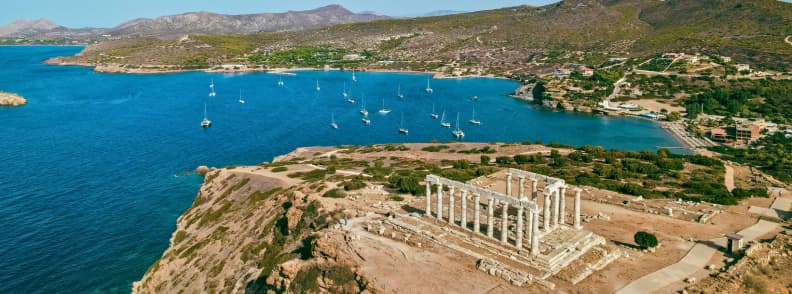
Cape Sounion, the Temple of Poseidon Above the Aegean
Perched dramatically on a cliff 70 meters above the sea, Cape Sounion is home to the Temple of Poseidon, one of the most iconic archaeological sites in Greece. Built in the 5th century BC, this marble temple honored the god of the sea and served as a beacon for sailors returning to Athens. Lord Byron famously carved his name into one of its columns, but today the real draw is the view: endless blue stretching across the Aegean.
The journey to Cape Sounion along the coastal road is an experience in itself, passing through small seaside towns and offering stunning glimpses of the Saronic Gulf. Buses run regularly from Athens’ city center, or you can rent a car for a more flexible schedule. The site is open daily, and sunset is particularly spectacular as the temple’s white columns glow against the fiery sky. Plan to spend at least two hours here, including time to enjoy the views.

Marathon, Where History and Legend Collide
About 42 kilometers northeast of Athens lies Marathon, the site of the legendary 490 BC battle where the vastly outnumbered Athenians defeated the Persians. This victory inspired the modern marathon race, commemorating the messenger who ran to Athens to deliver news of the triumph. The Archaeological Museum of Marathon showcases artifacts from the battle, while the Marathon Tumulus, a burial mound for fallen Athenian soldiers, provides a solemn reminder of the city’s resilience.
Reaching Marathon is easiest by car, but buses also run from Athens. A half-day visit is sufficient to explore the museum, the tumulus, and the surrounding area. Early morning visits are ideal, particularly in summer, when the heat is less intense.
These three destinations enrich an Athens trip by connecting you with broader Greek history and culture. Whether you’re drawn to mystery cults, coastal sanctuaries, or battlefield legends, each of these sites adds a new layer to understanding the world of ancient Athens.
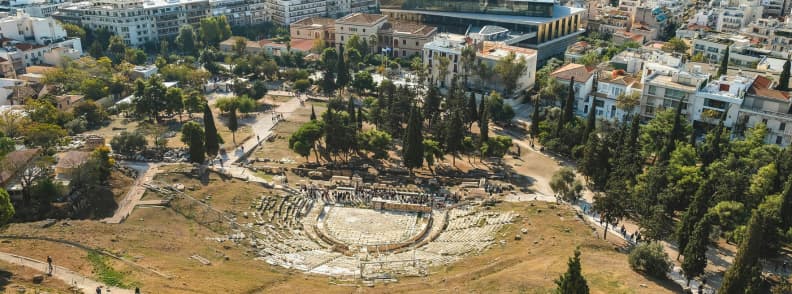
Practical Planning to Make the Most of Your Visit to Athens Greece
Visiting the archaeological sites of Athens can be a once-in-a-lifetime experience, but a little planning goes a long way in ensuring it is smooth, cost-effective, and enjoyable. From choosing the right tickets to knowing when to visit and how to move between sites, this section gives you everything you need to make the most of your time in the city.
Athens Archaeological Sites Tickets & Costs to Visit
Most major archaeological sites in Athens require paid entry, but you can choose between individual tickets and the Athens Acropolis and 6 Archaeological Sites Combo Ticket, which costs €30. This combined pass covers entry to the Acropolis, Ancient Agora, Roman Agora, Kerameikos, and the Temple of Olympian Zeus, making it a smart choice if you plan to visit several landmarks.
Free admission is available on specific dates, including the first Sunday of each month from November to March, as well as cultural holidays such as March 6, May 18, and the European Heritage Days weekend. It’s worth aligning your itinerary with these dates if your travel schedule allows, as it can save you a significant amount on entry fees.
When to Visit Archaeological Sites in Athens
The best seasons to explore Athens are spring (April to June) and autumn (September to October) when the weather is mild and crowds are smaller. If you are visiting during the peak summer months, plan your day carefully to avoid the midday heat. Luckily, in the warmer months, the archaeological sites Athens opening hours are extended.
The Acropolis, in particular, is best experienced either at opening time (8 AM) when it is quietest or near sunset, when the light softens and the crowds thin out.
Getting Around to Visit Athens Greece Archaeological Sites
Athens has a reliable and efficient metro system that makes getting to the archaeological sites easy. For the Acropolis and the Acropolis Museum, take the Red Line to Acropolis Station. The Roman Agora and Hadrian’s Library are accessible from Monastiraki Station on the Blue Line, while the Ancient Agora and Kerameikos are a short walk from Thissio Station on the Green Line. Many of these sites are close to each other, so you can combine Monastiraki, the Ancient Agora, and Hadrian’s Library into one walking route for a seamless day of sightseeing.
Athens Archaeological Sites Accessibility Improvements
Some archaeological sites, particularly the Acropolis, involve steep climbs and uneven paths, which can be challenging for visitors with mobility limitations. However, the Acropolis Museum is fully accessible, offering elevators, ramps, and accessible restrooms, making it an excellent option for travelers who require step-free access.
Greece Archaeological Sites Photography & Etiquette
The most flattering light for photographing Athens’ monuments is found in the early morning and late afternoon, when the harsh midday sun softens, and the marble glows. When exploring, remember to respect the sites by staying on marked paths and avoiding any climbing on ruins.
Athens Photo Tip: For an outstanding photograph of the Parthenon, skip the crowded main viewing platform and instead walk to the Areopagus Hill, where you’ll get a unique and less obstructed angle of this iconic temple.
Best Athens Archaeological Site Tours & Experiences
Exploring the archaeological sites of Athens can be as simple as wandering through ruins at your own pace or as enriching as joining a tour led by an expert. The city offers a variety of experiences, from flexible self-guided audio tours to in-depth walking tours with professional guides, as well as specialized options for photography enthusiasts, families, and history lovers. Choosing the right format depends on how deeply you want to engage with the stories behind these ancient stones.
Self-Guided vs. Guided Tour Options
For independent travelers, self-guided audio tours provide a flexible way to experience Athens sites. Many apps and operators now offer downloadable content with clear directions and engaging commentary, making it easy to navigate landmarks like the Acropolis, the Ancient Agora, or the Roman Forum on your own schedule. This is a budget-friendly option, and you can pause whenever you need a break or want to explore a spot in more detail.
However, there are significant advantages to joining a guided walking tour in Athens. With a professional guide, you gain a deeper understanding of the mythology, philosophy, and politics that shaped Athens. These tours often reveal fascinating context that you simply won’t find on plaques or in guidebooks.
Those visiting Athens with family benefit particularly from child-friendly itineraries that bring history to life with storytelling, while couples or solo travelers might enjoy the intimacy of private experiences compared to larger group tours. Whether you’re interested in a quick highlights walk or a more immersive multi-hour exploration, there’s a guided option to suit your pace and interests.
Specialized Archaeological Tours in Athens
If you want to go beyond the basics, specialized archaeological tours are an excellent choice. An Athens ancient monuments tour might include night access to the Acropolis, when the crowds have left and the city lights create an unforgettable atmosphere. An Athens Photo Tour is popular among those who want guidance on capturing the best angles of landmarks like the Parthenon or the Temple of Olympian Zeus, while avoiding the busiest times. For visitors with an academic interest, expert-led archaeology walks like the Athens Half-Day Tour to Acropolis, Parthenon & All Major Sights provide in-depth commentary on the architectural details, excavation history, and cultural significance of the sites.
Families can also choose tours tailored to young travelers, such as this Athens Guided Mythological Walking Tour, combining storytelling with interactive activities. These options make it easier for children to connect with the grandeur of Athens’ past. Many operators now offer customizable itineraries, allowing you to combine multiple archaeological sites with nearby museums or neighborhoods.
Athens Archaeological Sites Map
See more, spend less, and skip the guesswork with my Athens Archaeological Sites Map. My Athens Travel Guide app includes a detailed map of archaeological sites in Athens with routes I’ve personally walked, shortcuts that save time, and practical tips for visiting the 7 major sites on one ticket. Whether you want the fastest path between the Acropolis, Ancient Agora, and Temple of Olympian Zeus, or a slower, scenic route with hidden photo spots, this map of Athens archaeological sites shows you exactly how to do it.
Get access to my Complete Athens Travel Guide + Map for €20. Includes all future updates. Grab it now at 30% off until 7 September 2025 to plan like a pro and make your trip unforgettable.
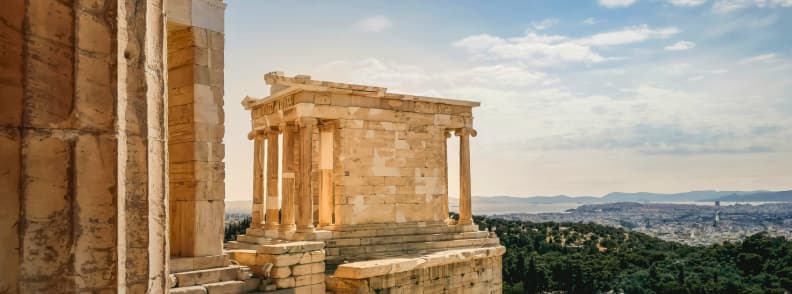
FAQs About Visiting the Athens Archaeological Sites
Planning a visit to Athens ancient sites? Whether you’re exploring the Acropolis, the Ancient Agora, or the Roman Forum, it’s important to know the best times to go, how to save money on tickets, and what hidden gems to look for. Here are the most frequently asked questions to help you make the most of your historical adventure in Athens!
When is the best time to visit Athens archaeological sites?
The best time to explore Athens’ archaeological sites is during spring (April-June) and fall (September-October). The weather is pleasant, and you’ll avoid the extreme summer heat and large tourist crowds. If you must visit in summer, go early in the morning (before 9 AM) or late in the afternoon to avoid the heat and tour groups. The golden hour light also makes for fantastic photos!
Are guided tours available to visit best archaeological sites Athens?
Yes! Athens archaeological sites have various guided tours, including group tours, private guides, and even audio tours. These provide in-depth historical insights that signage alone can’t offer. If you’re interested in Greek mythology, look for specialized tours that connect ancient sites Athens with mythological stories. You’ll get a deeper appreciation for places like the Erechtheion and the Temple of Olympian Zeus.
👉 Check out some of the best tours in Athens
Is the Athens Archaeological Sites Combo Ticket worth it?
Absolutely! The Athens Archaeological Sites Combo Ticket (€30) gives you access to: the Acropolis (including the Parthenon and Erechtheion), the Ancient Agora (including the Temple of Hephaestus), the Roman Agora, Hadrian’s Library, the Temple of Olympian Zeus, and Kerameikos. If you plan to visit at least three sites, the Athena Combined Ticket saves you money. It’s valid for five days, so there’s no need to rush!
What are the free admission days for Athens archeological sites?
If you’re traveling on a budget, you can visit Athens’ ancient sites for free on select days. Free admission is available on: the first Sunday of each month from November to March, 6 March (Melina Mercouri Day), 18 April (International Day for Monuments and Sites), 18 May (International Museums Day), the last weekend of September (European Heritage Days), 28 October (Greek National Holiday). These days can get very crowded, so arrive early to enjoy a more peaceful experience.
How long do I need to visit all Athens ancient sites?
To experience the main archaeological sites in Athens properly, you should allow at least two to three full days. This gives you enough time to see the Acropolis and Parthenon, the Ancient Agora, the Roman Agora, the Temple of Olympian Zeus, Hadrian’s Library, and Kerameikos without feeling rushed. If you include visits to the Acropolis Museum or the National Archaeological Museum, plan for additional hours as these collections are extensive and deserve unhurried exploration. Travelers who enjoy slower sightseeing or want to join a guided walking tour of Athens’ sites should consider extending their visit to four or five days. This pace also allows time for short day trips to places like Eleusis or Cape Sounion, which complement the historical experience of Athens.
What’s the difference between the Acropolis and the Parthenon?
The Acropolis refers to the entire fortified hilltop complex that dominates central Athens. It includes several ancient monuments, such as the Propylaea (the grand entrance), the Erechtheion with its famous Caryatids, the Temple of Athena Nike, and the Theatre of Dionysus, in addition to other important ruins. The Parthenon, on the other hand, is just one structure within the Acropolis, albeit the most iconic. It was built in the 5th century BC as a temple dedicated to Athena Parthenos, the city’s patron goddess, and remains one of the greatest achievements of Classical Greek architecture. While the Parthenon often represents the Acropolis in popular imagery, visiting the site reveals that it is only part of a much larger complex of archaeological treasures that reflect Athens’ cultural, political, and religious importance in the ancient world.
How can I support The Travel Bunny?
If you find this Athens travel guide helpful, you can support The Travel Bunny by:
✅ Booking your tours, accommodations, or tickets through the links on our website.
✅ Sharing this guide with fellow travelers who love Athens and Greek history.
✅ Following The Travel Bunny on social media for more travel tips and hidden gems!
Thank You! Every little bit helps keep these insider travel guides free and packed with first-hand experiences. Happy exploring!

